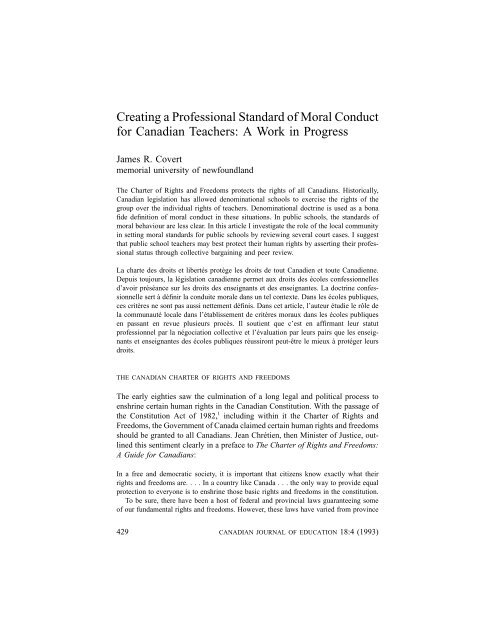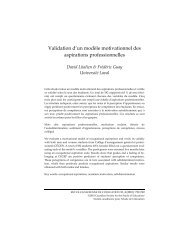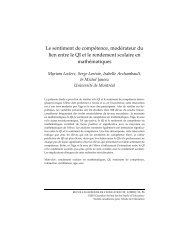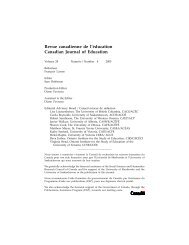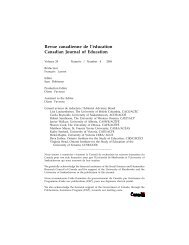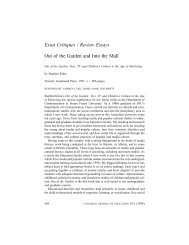Mireille Falardeau et Michel Loranger Le choix de stratégies ... - CSSE
Mireille Falardeau et Michel Loranger Le choix de stratégies ... - CSSE
Mireille Falardeau et Michel Loranger Le choix de stratégies ... - CSSE
You also want an ePaper? Increase the reach of your titles
YUMPU automatically turns print PDFs into web optimized ePapers that Google loves.
Creating a Professional Standard of Moral Conduct<br />
for Canadian Teachers: A Work in Progress<br />
James R. Covert<br />
memorial university of newfoundland<br />
The Charter of Rights and Freedoms protects the rights of all Canadians. Historically,<br />
Canadian legislation has allowed <strong>de</strong>nominational schools to exercise the rights of the<br />
group over the individual rights of teachers. Denominational doctrine is used as a bona<br />
fi<strong>de</strong> <strong>de</strong>finition of moral conduct in these situations. In public schools, the standards of<br />
moral behaviour are less clear. In this article I investigate the role of the local community<br />
in s<strong>et</strong>ting moral standards for public schools by reviewing several court cases. I suggest<br />
that public school teachers may best protect their human rights by asserting their professional<br />
status through collective bargaining and peer review.<br />
La charte <strong>de</strong>s droits <strong>et</strong> libertés protège les droits <strong>de</strong> tout Canadien <strong>et</strong> toute Canadienne.<br />
Depuis toujours, la législation canadienne perm<strong>et</strong> aux droits <strong>de</strong>s écoles confessionnelles<br />
d’avoir préséance sur les droits <strong>de</strong>s enseignants <strong>et</strong> <strong>de</strong>s enseignantes. La doctrine confessionnelle<br />
sert à définir la conduite morale dans un tel contexte. Dans les écoles publiques,<br />
ces critères ne sont pas aussi n<strong>et</strong>tement définis. Dans c<strong>et</strong> article, l’auteur étudie le rôle <strong>de</strong><br />
la communauté locale dans l’établissement <strong>de</strong> critères moraux dans les écoles publiques<br />
en passant en revue plusieurs procès. Il soutient que c’est en affirmant leur statut<br />
professionnel par la négociation collective <strong>et</strong> l’évaluation par leurs pairs que les enseignants<br />
<strong>et</strong> enseignantes <strong>de</strong>s écoles publiques réussiront peut-être le mieux à protéger leurs<br />
droits.<br />
THE CANADIAN CHARTER OF RIGHTS AND FREEDOMS<br />
The early eighties saw the culmination of a long legal and political process to<br />
enshrine certain human rights in the Canadian Constitution. With the passage of<br />
the Constitution Act of 1982, 1 including within it the Charter of Rights and<br />
Freedoms, the Government of Canada claimed certain human rights and freedoms<br />
should be granted to all Canadians. Jean Chrétien, then Minister of Justice, outlined<br />
this sentiment clearly in a preface to The Charter of Rights and Freedoms:<br />
A Gui<strong>de</strong> for Canadians:<br />
In a free and <strong>de</strong>mocratic soci<strong>et</strong>y, it is important that citizens know exactly what their<br />
rights and freedoms are. ...Inacountry like Canada . . . the only way to provi<strong>de</strong> equal<br />
protection to everyone is to enshrine those basic rights and freedoms in the constitution.<br />
To be sure, there have been a host of fe<strong>de</strong>ral and provincial laws guaranteeing some<br />
of our fundamental rights and freedoms. However, these laws have varied from province<br />
429 CANADIAN JOURNAL OF EDUCATION 18:4 (1993)


